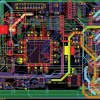Indispensable Material in PCB Manufacturing - Copper Foil: Detailed Interpretation of Specifications, Functions, and Technical Standards
May 19, 2023
Indispensable Material in PCB Manufacturing - Copper Foil: Detailed Interpretation of Specifications, Functions, and Technical Standards
Copper foil is a cathode electrolytic material, a thin and continuous layer of metal foil that precipitates on the substrate layer of the circuit board, serving as the conductor of the PCB. It easily adheres to the insulation layer, accepts printed protective layers, and forms circuit patterns after corrosion. The copper mirror test is a flux corrosion test that uses a vacuum-deposited film on a glass plate.
Copper foil is made by punching copper with a certain proportion of other metals. There are generally two types of copper foils: 90 foils and 88 foils, which contain 90% and 88% copper, respectively, and have a size of 16*16cm.
The commonly used thicknesses of international PCB copper foils are: 35um, 50um, and 70um. The thickness of the copper foil (covering copper) on a single or double-sided PCB is usually about 35um (1.4mil), and another specification is 50um and 70um. The surface thickness of the multilayer board is generally 35um = 1oz (1.4mil), and the inner layer is 17.5um (0.7mil). 70% of circuit boards use a finished copper foil thickness of 35um, which mainly depends on the purpose of the PCB and the voltage and current of the signal. In addition, for PCBs with large currents, some may use 70um copper thickness, 105um copper thickness, and even 140um, etc.
The thickness of the copper foil is usually expressed in oz (ounces). 1oz means that the thickness of copper evenly covering 1 square foot of area is approximately 1.4mil, which is the average thickness of the copper foil expressed in weight per unit area. The formula is: 1oz=28.35g/FT2 (FT2 is square feet, 1 square foot = 0.09290304 square meters).
The thickness of the copper foil (trace width) will affect the current size. Although there is already a formula that can directly calculate the current carrying capacity of the copper foil, in actual circuit design, it is not that simple. Therefore, safety factors should be fully considered in the design.
Recent Posts

October 26, 2016
The Most Successful Engineering Contractor
May 12, 2025
China PCB Drilling Routing machine Development
May 06, 2025
PCB Design Process and Key Points






